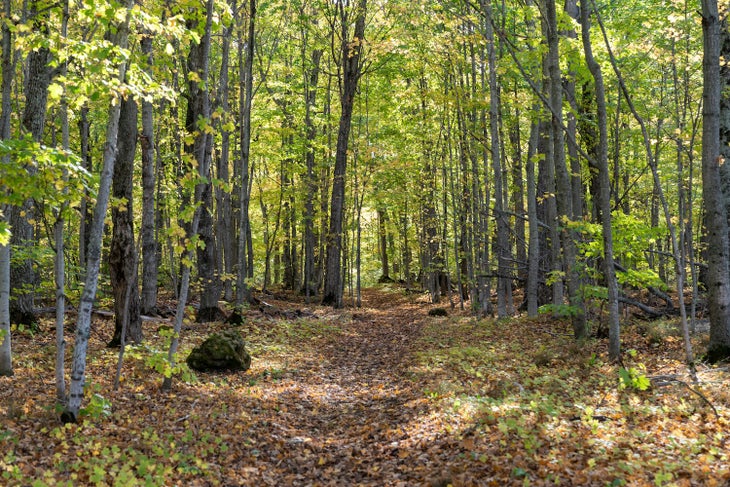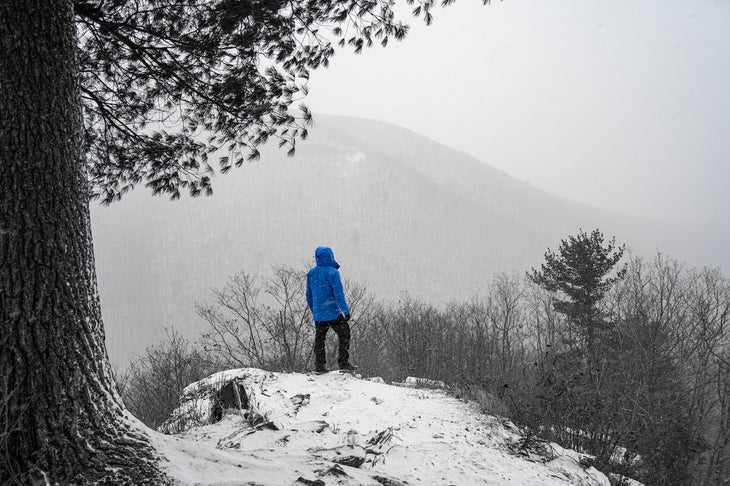If you buy through our links, we may earn an affiliate commission. This supports our mission to get more people active and outside.Learn about Outside Online's affiliate link policy
How to Hike America’s Longest National Scenic Trail in a Day, a Month, or a Year

(Photo: groveb via Getty Images)
The North Country Trail (NCT) is a beast of a backpacking route. The 4,800-mile footpath runs from North Dakota’s grasslands through Minnesota’s Boundary Waters, along the north shoreline of Michigan’s Upper Peninsula, down to Ohio, over to Pennsylvania, across New York, and finally, ends in Vermont. (Whew!)
To put it simply: The NCT is a trail of contrasts. Every mile opens hikers’ eyes to a new landscape—from glacial lakes and boreal forests to sandstone cliffs and wide-stretched prairies. This ultra-scenic and geographically diverse trail offers countless sections for dayhikes and long-distance backpacking options, too, if a full thru-hike sounds like a bit much to take on in one go.
In this guide, we cover what to know about hiking the North Country Trail so you can get a sense of what a journey (long or short) on this epic trail is all about.
How many miles is the North Country Trail?
The main route most hikers refer to when talking about the North Country Trail is its 4,800-mile backbone stretching from the prairies of North Dakota in the west to the rolling Green Mountains of Vermont in the east. “Bucket list” sections of the NCT include Minnesota’s Boundary Waters, Pictured Rocks National Lakeshore in Michigan’s Upper Peninsula, and New York’s Finger Lakes region. Trail segments along the NCT are managed by the North Country Trail Association (NCTA) and its partner organizations in each of the eight states (North Dakota, Minnesota, Wisconsin, Michigan, Ohio, Pennsylvania, New York, and Vermont) they pass through.
How long does it take to hike the North Country Trail?
An entire North Country Trail thru-hike usually takes over a year for most hikers. Fast hikers tackling upward of 20 miles per day—with few “zero days”—can complete the trail in closer to seven to nine months. Due to its sheer mileage, most choose to section-hike the trail rather than take it on in one continuous journey. Dozens of popular trailheads are a stone’s throw from major cities like Minneapolis/St. Paul, Detroit, Cleveland, and Buffalo. Popular wilderness areas for section and dayhiking along the NCT include the Allegheny National Forest in Pennsylvania, Cuyahoga Valley National Park in Ohio, and Manistee National Forest in Michigan.
Where can you dayhike on the North Country Trail?
If you can’t commit to a full thru-hike, shorter dayhikes at scenic access points are a great option for seeing the best of the NCT. In fall, pit-stop at Lake of the Clouds Overlook in the Porcupine Mountains in Michigan’s Upper Peninsula for sweeping wilderness views. Here, sugar maples and aspen light up in every shade of orange, yellow, and red from mid-September through mid-October. Also, 45 minutes north of Duluth on Minnesota’s north shore, head to Gooseberry Falls State Park, which offers a range of loops that pass gushing waterfalls and vistas overlooking Lake Superior.
Winter hikes here are just as stunning as the summer months, with frozen falls and whisper-quiet, snow-blanketed trails. Spring in Ohio’s Cuyahoga Valley National Park ushers in a wave of wildflowers that pop off in late April to early June. Look out for Virginia bluebells, purple cress, and great white trillium that engulf the forest along the shared 40-mile NCT and Buckeye Trail segment in the national park.
When it comes to warm-weather hiking, you can’t beat summer in the Finger Lakes region. Notably, the 422-mile NCT segment following the Finger Lakes Trail flaunts shady trails with towering oak and eastern white pine, and plenty of waterfalls and creeks to cool off in along the way.
Do you need a permit to hike the North Country Trail?
Unlike the well-known Pacific Crest Trail or even the lesser-traveled Lost Coast Trail, the NCT does not require a permit. You can thru-hike, section-hike, and dayhike the trail without an overarching permit. Some overnight camping permits are required in specific state and federal-managed forest areas along the NCT. Forest areas and trails within North Dakota, Ohio, Pennsylvania, and New York typically do not require an overnight camping permit.
Popular sections that include overnight camping permits include Pictured Rocks National Lakeshore (Michigan), Porcupine Mountains Wilderness State Park (Michigan) and Boundary Waters Canoe Area Wilderness (Minnesota). Hikers should carefully review rules set by the state or federal agency that manages the specific areas where they intend to stay overnight.
Season-by-Season Guide: Thru-Hiking the North Country Trail
Hiking the entire NCT is a massive undertaking, but totally doable if you’re up for the challenge. Truth is, there are many approaches to tackling a thru-hike of the NCT. Here is our suggested 12-month timeframe to start and end your thru-hiking travels—beginning at the western trailhead in North Dakota and finishing at the eastern terminus in Vermont.
Season: Late Spring
Timing: Mid-May to June
States: North Dakota → Minnesota
The majority of hikers start their journey at the western trailhead near the Sheyenne National Grasslands in North Dakota. Winters are brutally cold in the plains and upper Minnesota, so it’s recommended to start your hike in May or June once the winter chill thaws. Heading east into northern Wisconsin and northern Minnesota, hikers will enjoy spring in the Upper Midwest—when snow has melted and conditions are manageable. Springtime mud may be abundant during this time of year, so prepare accordingly.
Season: Summer
Timing: July to August
States: Minnesota → Wisconsin → Michigan’s Upper Peninsula
Cold dips in the chilly water of Lake Superior along the North Shore of Minnesota and the Pictured Rocks National Lakeshore are ideal to ease the aches and pains of double-digit days on the trail—not to mention, cool off. You’ll miss peak black fly season in the Upper Peninsula (May and June) by hiking this region this time of year. While inland stretches along the north edge of the Ottawa National Forest can be hot and humid, Lake Superior’s breezy shoreline is a welcome treat throughout this stretch of trail. It’s also arguably the most scenic section of the NCT for its boreal forests and dramatic cliffs overlooking Lake Superior.

Season: Fall
Timing: September to November
States: Michigan’s Lower Peninsula → Ohio
September and October usher in crisp days and bug-free campsites with glowing peak color engulfing the journey. Some may argue that upstate New York and Vermont can’t be beat for their fall foliage. But Michigan and Ohio punch above their weight class for autumn color in dense forests like Manistee and the Hocking Hills region in Ohio. By November, you’ll reach southern Ohio, where you can expect cold weather, but milder conditions than in the northwoods. This segment of the NCT in the Lower Peninsula of Michigan and western Ohio is characterized by quiet forests and small-town resupply stops, with more frequent road crossings and easier terrain compared to the rugged Upper Midwest.
Season: Winter
Timing: December to February
States: Ohio → Pennsylvania
While snow and ice are common during winter months on the North Country Trail, southern and eastern Ohio, and Pennsylvania, are more tame than in the northern states. Winter becomes more about stamina, endurance, and patience to get through the colder weather. Swap your summer gear for warmer sleep systems and a sturdier tent to fend off snow should you find yourself in some. Winter in Ohio’s Wayne National Forest especially surprises and delights with frequent sightings of deer, wild turkey, fox, and even bald eagles. Not to mention, wildlife (and their tracks) are way easier to spot in the open woods during this time of year.
Season: Spring
Timing: March to June (Year 2)
States: Pennsylvania → New York → Vermont
Hikers’ final push on the NCT culminates with the stunning scenery of the upper East Coast. Rolling landscape with deep valleys and rolling ridges defines Pennsylvania’s Allegheny highlands—known as the Appalachian Plateau—and upstate New York. Lingering snow patches and muddy trails will make up a lot of March. But by early April through May, the forests here burst with blooms and waterfalls that run full, making it easy for hikers to replenish at water sources. Spring hiking on the NCT doesn’t get much better than navigating flower-flanked trails through the Finger Lakes region, with trout lilies, trilliums, and bloodroot making appearances. In the homestretch of June, hikers will climb into Vermont’s Green Mountains for a rugged finale before closing out nearly 5,000 miles on one of America’s most expansive trails.

What to pack for the North Country Trail
Hiking long distances requires substantial backpacking gear. But there are a few items to pack for an NCT hike that will make your time more enjoyable than without them.
Bug protection
Black flies, ticks, and mosquitoes are relentless along many sections of the North Country Trail, mainly in Michigan, Minnesota, and Wisconsin, during the spring and summer months. June and July in particular are notorious months for insects. You’ll want to pack a head net (we like the Coughlan No-See-Um Head Net) and treat your hiking clothing (pants, hats, socks, shirts) with permethrin before hitting the trail. Or, invest in this tried and tested bug-free hiking gear.
Adequate footwear
The NCT throws all kinds of terrain at you: sandy shorelines, rocky ridgelines, muddy valleys, and seemingly endless prairie. Trail runners are a safe bet for their ability to handle varied terrain (and dry out quickly). Pro tip: Avoid waterproof shoes, which tend to trap moisture, as the weather on the North Country Trail is often unpredictable.
Navigation (downloadable or paper)
Remote sections of the NCT aren’t marked as prominently as other, more commonly thru-hiked trails like the Appalachian Trail or the PCT. Opt for a handheld or wearable GPS to stay on track.
Winter-specific tent
NCT hikers can get away with a three-season tent most of the year. But for those hiking in colder months, camping in the winter requires a specific set of gear. Swap your tent in late fall and winter (November through March) for one with a stronger pole structure, thicker fabric, and a lower profile.